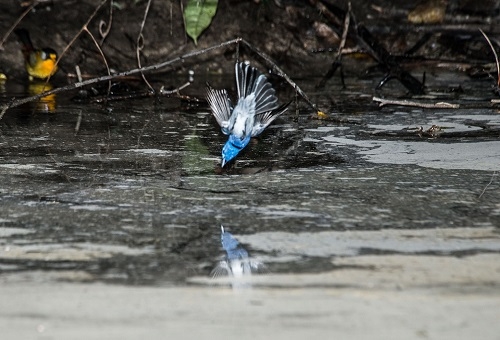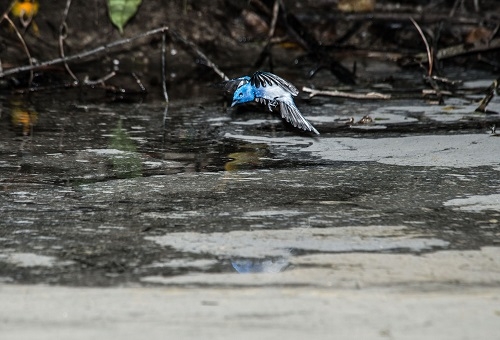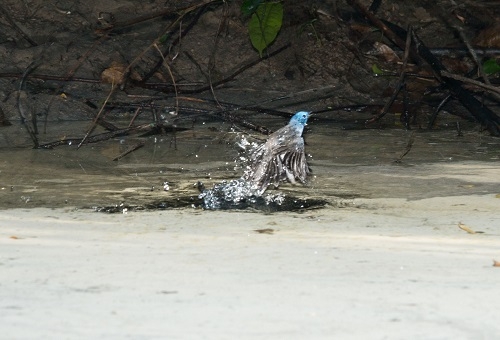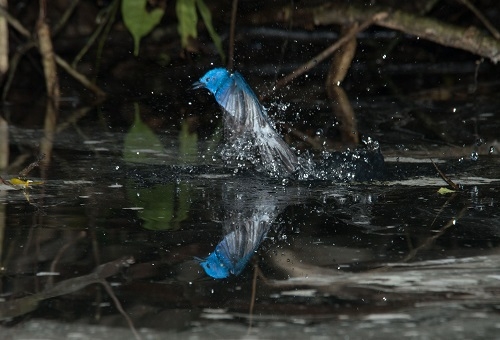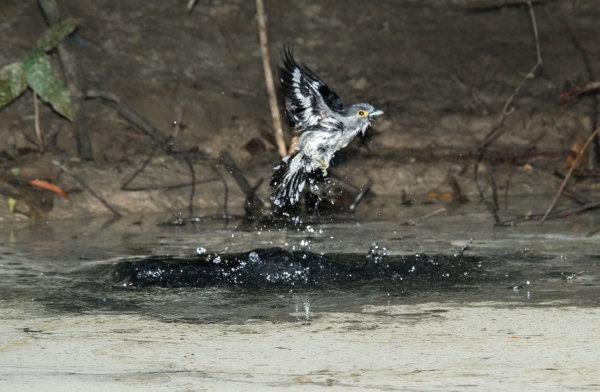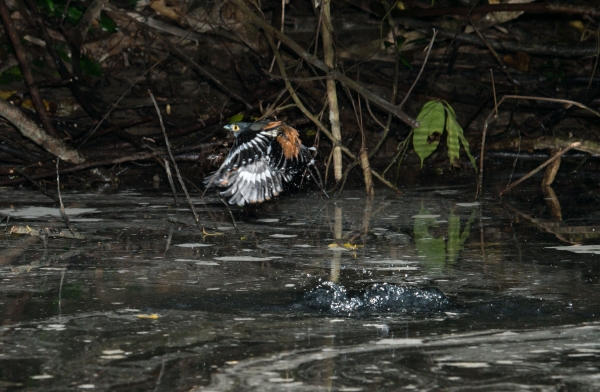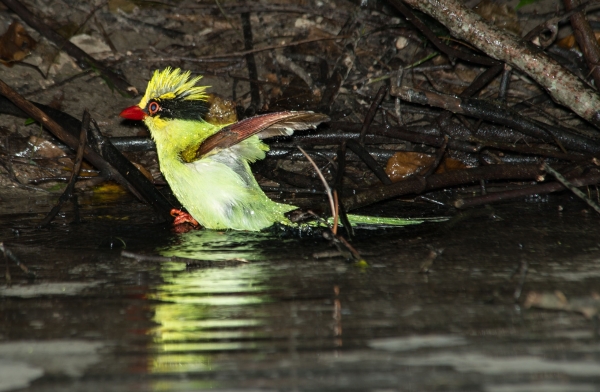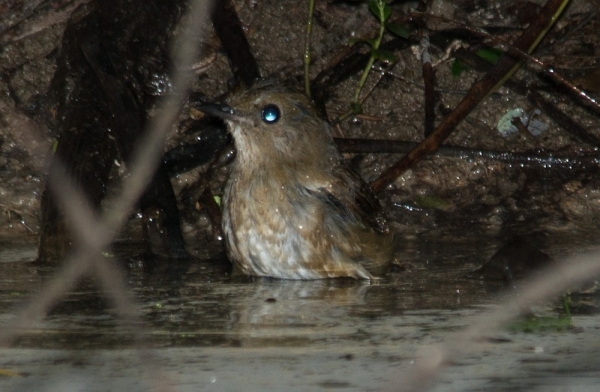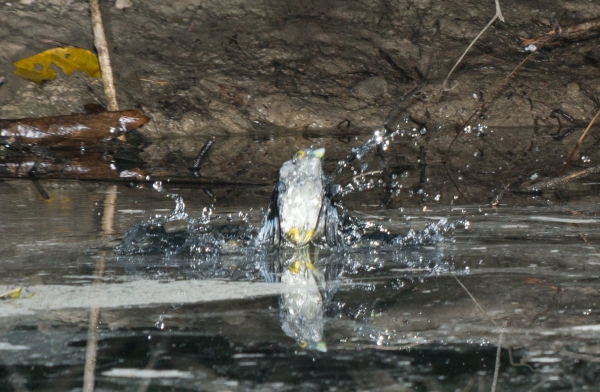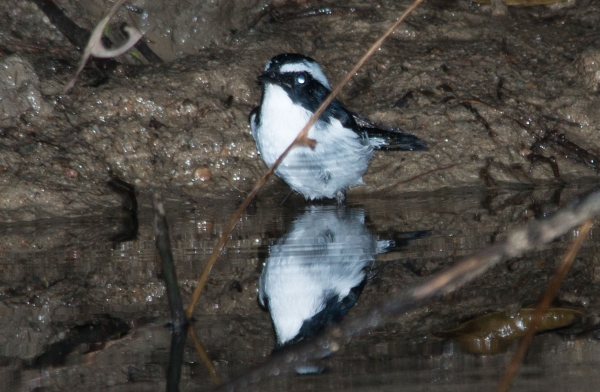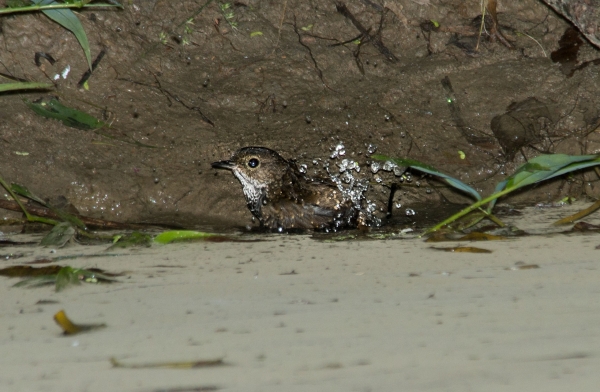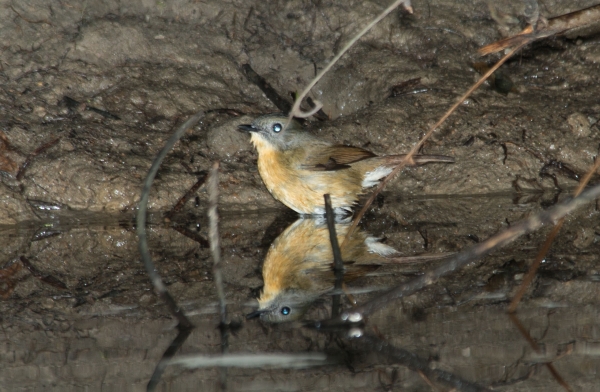Bathing Behaviors of Birds - Journal of the Pond (From M3B-Bird Training, Manas Park Range)
We understood that the Manas Park Range Management had instructed the UWICE alumni (along with boatmen) to assist the M3B-Bird Training participants to be ferried across the Drangme Chu (Manas river) and guide them to their allotted campus lodge. They also provided help with lugging belongings.
Upon our arrival to the campus, Mr. Jampel Lhendup (UWICE alumnus-2010), narrated to us that they have an artificial pond, west of the campus, at a distance of about 10 minutes walk. Mr. Jampel knew the operations of the pond quite well. He had the story of wildlife—birds, mammals and reptiles—that use the pond. He highlighted visitation evidences left by ungulates such as sambar, barking deer, wild pig, water buffalo, gaur and even elephants; predatory large cats from leopard cats to massive tigers; carnivores like bears and binturong; reptiles such as snakes, skunks and monitor lizards; birds varying in size from as large as canopy hornbills to as little as little pied flycatchers. Now the task was to attest Mr. Jampel’s assertions of wildlife sightings at the pond.
On the evening of 17th November 2013, Mr. Jampel Lhendup heralded us (Ugyen Tenzin, Tobias Schimid and Sherub) to the pond. Nearing the pond, we tried to take a gentle gait in our walk so as not to scare away any wildlife around the pond. We saw a couple of bird species and evidences of mammalian species in the mud around the pond. We settled and stood in the thickets of the undergrowth around the pond, watching species come to the pond. We were excited to see birds come to the pond, and we left for the campus by the light of the winter dusk. The co-conductors (Dr. Ellen and Sherub) of the training discussed and decided that the pond is the best potential birding site for beginners like the M3B-Bird participants or any who enjoy bird watching. We discussed with Mr. Jampel regarding the best time for birding in the area. He told us that a good time to start birding is from 0700 hours in the morning. Prior to that hour the cold morning winds of the Himalayas funnel through the river valleys from the north, making it difficult for the birds to come out. We were a bit skeptical on his observation and really wanted to find this out for myself.
The participants were to arrive at the Manas Park Range by the evening, from various parts of Bhutan. We saw participants arrive at the campus and a few of them were a bit frantic to phone call their near and dear ones—Manas does not have mobile phone connections, thus some participants drove towards Panbang or to Panbang to intimate of their safe arrival at the Manas Park Range. After the dinner, the course coordinators and participants met to briefly discuss an outline of the training program. At the meeting, it was decided that bird watching would begin on the morning of 18th November 2013 at 0545 hours.
On the morning of 18th November 2013, we went for a morning bird watch at 0545 hours; the weather was as windy as Mr. Jampel described, yet we continued thinking that it would be a one-morning incident. We watched for birds in the grasslands on the banks of Drangme Chu, and in the high subtropical forests, in the windy weather. As we entered the high forests, the winds sometimes became strong in certain pockets. The rustles of leaves were strong and cracking sounds from the rubbing of the tree trunks and branches were a bit scary. We also heard branches break and fall on the ground. The bird watching was a bit unproductive.
From the next day we rescheduled our bird watching time. A guided morning bird watch was a daily feature of the training program activity. We took the participants to the pond two times, but we found out that disturbance to the birds at the pond was noticeable, thus we discontinued going together, and instead, our visit to the pond was scheduled in smaller groups. From the middle of the training duration, visit restrictions to the pond in the afternoon were posted, with exceptions for the photographers (Mr. Tobias Schimid and Sherub). This decision was made to maximize opportunities for photographing bird species, so bird pictures of each species could be then shared with all participants. The pond measured about 24 square meters.
The pond has so much to offer, and the water (in its various states) is such a resource that life forms cannot survive without it. The pond had life, and its life had various exhibitions. Here, we try to document water use behaviors by various bird species. Each species has its own style of using water at the pond, and each individual has its own trait of use as well. While resource-use partitioning is designed to optimize resource use, it also facilitates the evolution of species traits to maximize gain for itself. At the pond, we found bird species that were regular visitors and other species with clear visitation patterns. We observed the drinking and bathing behaviors of many different bird species. Here, we restrict our documentation to water bathing behavior. Besides foraging, bathing is an important daily maintenance activity for birds.
Dip-bathing: From day break till the dusk of twilight, the pond is never absent of birds—although there were intermittent gaps without birds. Those birds that fail to get water the previous day come to the pond early in the morning for a drink, but they do not take a bath. Birds come for drink and bath from 1000 hours onwards. Dip-bathing here is described as a bathing behavior of those bird species that come to the edges of the pond, dip or immerse their body partially or wholly into the water and cleanse their external part of the body, especially their plumage. Some species dip their vent and tail first followed by body and head; some species immerse their head first followed by body, vent and tail. After a dip in the water the bird shakes its body and plumage vigorously, and flutters its wing and tail feathers, followed by shaking, drying and preening. Then a bird takes a beautiful form and shape. The largest flock bird to come for dip-bathing was Leiothrix argentaurus (Silver-eared Mesia). These birds come to a spot protected by twigs of the fallen branches of trees. They come noisily, dip in water and flutter to complete their bath.
With the largest flock of Silver-eared Mesia was a loner Leiothrix lutea (Red-billed Leiothrix) that later abandoned the mesia; it was all by itself.Cissa chinensis (Common Green Magpie) came to the pond every day at around 1630 hours. When it dipped its head in the water, one could see the crown feathers dangle like a crest. Other regular visitors to the pond were Myiomela leucura (White-tailed Robin), Niltava sundara(Rufous-bellied Niltava), Niltava macgrigoriae (Small Niltava), Copsychus malabaricus (White-rumped Shama), Ficedula westermanni (Little Pied Flycatcher), Cyornis poliogenys (Pale-chinned Flycatcher), Eumyias thalassina (Verditer Flycatcher), Ficedula hyperythra (Snowy-browed Flycatcher), Pellorneum ruficeps (Puff-throated Babbler), Malacocincla abbotti (Abbott’s Babbler), Pycnonotus melanicterus (Black-crested Bulbul), and Alophoixus flaveolus (White-throated Bulbul). Just prior to the fall of dusk came Lesser Shortwing, Tesia cyaniventer (Grey-bellied Tesia), Tesia castaneocoronta (Chestnut-headed Tesia) and Pnoepyga pusilla (Pygmy Wren Babbler). The Orange-headed Thrush visited the pond on alternate days for its dip-bathing. Golden-fronted Leafbird and Scarlet Minivet occasionally visited the pond.
Plunge-bathing: We observed other bird species that did what we call plunge-bathing. Plunge-bathing is defined as a bathing behavior in which a bird flies from a perch and plunges into the open space of the pond, then flies back to a perch, getting a complete soak with water during the plunge. The first bird species that we observed plunge-bathing was Hypothymis azurea (Black-naped Monarch). The species dives into water head-down and then pulls out of the water to perch and perform shaking, drying and preening. They repeat this several times. When a bird is excited the black nape is raised to form a short tuft of black crest. Serilophus lunatus (Silver-breasted Broadbill) does a stronger plunge bathing.Tephrodornis gularis (Large Woodshrike) does a beautiful plunge-bathing. A flock comes in line file and plunges into the pond one after another, in rapid fire mode. The Bronzed Drongo and Ashy Drongo are other species that exhibit plunge-bathing; however, they are comparatively slower in taking off from the water after the plunge. The White-bellied Yuhina also exhibits plunge-bathing.
Bird species such as the Blue-bearded Bee-eater, and Lesser and Greater Racket-tailed Drongos came to the pond but they left the pond upon finding the photographers. The Emerald Dove primarily visited the pond every day for a drink, but not for a bath.
On the 26th of November 2013, two wild pigs came to the pond right after we had settled into a camouflaged space. They walked by the pond and checked our presence, but felt comfortable to drink from the pond. We were watching through the lens of the camera, and observed a pig put its snout onto the water. As they sipped water from the pond, I could hear the sound of their drinking.
The 29th of November 2013 was our last evening in Manas, and we already had in us a feeling of missing the pond and its visitors. Like a departing send-off, lots of birds came to the pond and in huge numbers. At around 1600 hours, we heard the rustle of the leaves on the ground about 10–15 meters from where we sat. Our eyes were fixated in the direction of the sound. We initially assumed the rustles could be from Red Junglefowl, but then we saw a figure dragging long. The sound came nearer to us (Dr. Ellen Cheng and Sherub) and the pond; we whispered to each other that it is a Monitor Lizard. The lizard came as close as 5 meters to us, raised its head on its forelimbs and scanned the area. We established eye contact, then the lizard dashed away at its fullest speed. We saw the movement of its eyeball. Had we not established eye contact, it might have come to the pond. After the Monitor Lizard ran west, we heard the forest break into a chorus of barking (Barking Deer), the raucous calls of Hornbills, and the screams of Golden Langurs.
We owe our thanks to the Park Management and the Range Management for all their valuable support for the cause of the training.

